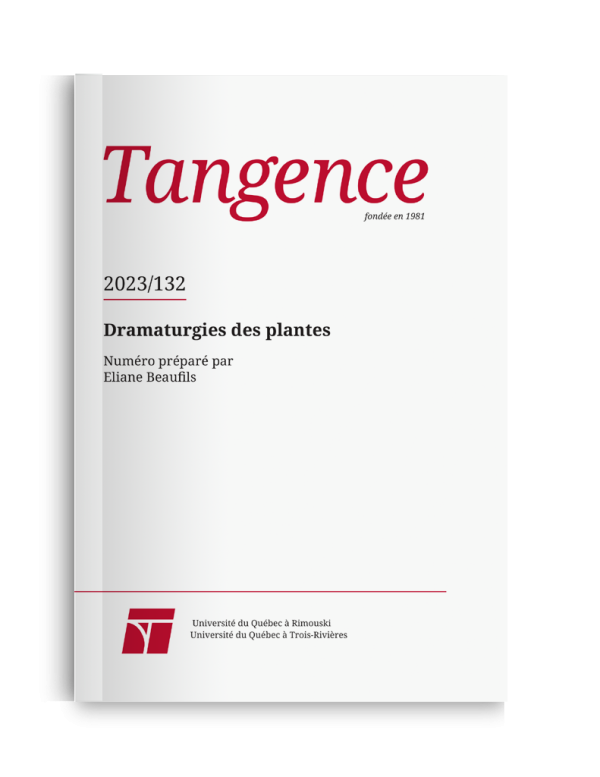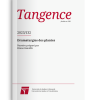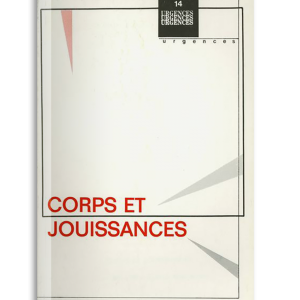Meetings of plant life and attentional practices in Branché and We Move Together Or Not At All
Catherine Cyr
This article focuses on the reception of two recent performative works dedicated to bringing together humans and plants : the ambulatory show Branché, by the circus companies Acting for Climate Montreal and Barcode, and the long-term choreographic installation We Move Together Or Not At All by Sasha Kleinplatz. Using a soma esthetic perspective that considers the feeling and experiencing body as the site of the development of thought, we examine how the meeting with plants and other components of the environment determines and affects the viewer experience. To report on the sensory dimension of this experience, the author privileges, in part, a self-ethnographic methodology in which fragments taken from her field notebook and later transcribed in writing are integrated into the analysis. Developing a theoretical network between fields of studies related to the performing arts, eco-criticism, environmental philosophy and Critical Plant Studies, the article centers on the effects and affects created by the agency and bioperformativity of plants in performance. It discusses the shift and intensification of attentional practices and the eminently political dimension of this reconfiguration.
Becoming a forest (Narrative)
Alix de Morant
After the unique experience of Kerminy, the author raises the question of artistic creation in situ. This article forms a diptych with that of Marina Pirot with the aim of pursuing a dialogue on the tools at our disposal to combat the crisis of life ; it is based on our shared research regarding the techniques and teachings of Body Weather (the intersections of bodies and their environments). Returning to the workshop Devenir vegetal (Becoming Plants), the author narrates, through the lens of an ecology of experience, a necessary return to the landscape as a person of experience and to dance as a holistic practice of feeling.
Artist/market gardener
Marina Pirot
This article presents the recent years of the author’s journey, from research in dance to the creation of a third place of agriculture in art, Kerminy. The relationship of the two terms, art and agriculture, guides the discussion based on the field of dance, performance and somatic practices. By discussing her artistic experience with market gardeners and training in market gardening techniques together with somatic practices, the author presents public body workshops regarding vegetation in forests and cultivated areas. At Kerminy, she creates and invests a “greenhouse-laboratory-stage” to invite market garden dancing via methods to divert the codes of the art scene. Thus, this space attesting to a potential renewal of the modes of production and dissemination of art relative to ecological issues is used to present other examples of third places and artistic approaches in agricultural or rural areas. The weave of art and agriculture invites artists to contribute to the places of work they invent, those related to the regeneration of the earth and our living bodies.
Bodies and plants : to carry or adopt
Pascale Weber
This article discusses how the Hantu duo (Weber+Delsaux) came to create mises-en-scène and performances centered on moving about with full vegetated containers. Such arrangements allow us to examine the act of carrying. We carry what we share : a heritage, claims, hopes for change… This act also testifies to the emotional bonds and new social relationships we could develop with plants. But carrying may also reinforce the notion that we have the power to manipulate plants, to move them about and arrange them as we please, referring to a passive view of plant life. As a counterpoint to carrying, the article develops the principle of plant adoption, one that allows us to see the plant as a living subject, recognize its agency and assume a shared relationship, given that adoption implies mutual commitment. Using the example of experiments, performances and workshops conducted by Weber and Delsaux, this text aims to understand the extent to which the principle of adoption can be transferred to the plant world and what it means to respect, consider and assume responsibility for a plant, and vice versa.
“There’s nothing to see.” On the difficulty of representing plant life on stage
Chloé Déchery
“There’s nothing to see.” A plant on the boards is a non-event. Its time is other, longer or shorter than human time ; its mobility and transformative capacity imperceptible to the naked eye. The plant, poor relation of the theatrical object and the marionette, disappoints by its struggle to enter the dramatic field. How, then, can plant life be included and represented on stage ? How do we report on this alter body and its singular plastic and choreographic language ? After describing the restoration of a research-creation process that led to the manufacture of a hybrid and roboticized burdock to create the play Bardane et moi (2022), this article opens with a typology of the modes of representation of plant life in two contemporary theatre and dance shows. These works present the plant, co-present with other living things, as part of a discursive, somatic and/or sensitive dialogue that has the plant body and the body of the interpreter co-exist in a full relationship, nurtured in turn by care, competitiveness, domination, exploitation or attention. By examining these case studies, the article reveals how this relationship model allows us to move beyond the issue of theatrical image.
Experiencing plants in the theatre : leave the black box or stay there ?
Flore Garcin-Marrou
Inside, as outside, in the black box or the in situ, plant life motivates the artist to create a parliament of plants, which take on the challenge of establishing the existence, within a play, of beings other than human actors. The plant proclaims itself a protagonist, liberated from its status as a decorative accessory. Plant worlds thus attain an enunciative and semiotic dimension, allowing them to restore a balance to the relationships between speaking and acting humans and nature, which is no longer reduced to its decorative function. These plant worlds prompt humans to transform their modes of enunciation, of understanding the world, and persuade them to transform their living environments, considering that plants are capable of “socially sculpting” (according to Joseph Beuys) contemporary stages.
Team up with plants ? Four participatory performances and their impacts
Eliane Beaufils
“We are not alone,” and humans owe it to themselves to discover their alliances with plants, suggest Lena Balaud and Antoine Chopot. In the four performances studied, viewers discover plants in situ and interact with them. But to what extent can these participatory forms rely on viewers’ participation to inspire images of human-plant alliances by beginning to develop them during the performance ? Hypothesis and analysis rest on four highly dissimilar arrangements, two audioguided journeys calling for sensitive and poetic interactions between participants and plants, a third that radically fictionalizes the plants encountered, and a fourth that invites viewers to become the parliamentarians of the organisms. The arrangements suggest modalities, also highly diverse, for teaming up with plants : from a sculpture sensitive to the guerilla environment, to the planning of our cities and even the establishment of a democracy. But vectors of the alliances are many and varied, calling for sensitivity, transmission of information and action so that they appear to complement each other and result in meaningful experiences. They favour diverse modes of inter-relationship as well as shifts from cognition or action to embodied knowledge.
On the proximity of performance with plant life. Or : how to learn the songs of the plants
Bojana Kunst
This article views the proximity between plant life and stage performance from two perspectives. The first part shows that proximity with plants requires a sensual, temporal and intimate adjustment. This adjustment, or syntony, acts upon our senses and relates to the deployment of the esthetic and poetic imagination. Performance can also be a space for the poetic invention of proximity and the overlap of humans and plants. At the same time, this rapprochement can occur only if the proximity to plant life has performative consequences for theatre. The second part of the article purports to show that a veritable proximity affects the social, political and aesthetic relationships across which the theatre exists. Given that photosynthesis is rarely possible in theatres, plant life also disrupts the community the theatre wishes to establish. The proximity of plants changes the way performance exists in the world ; it destabilizes how performance exists poetically, aesthetically and institutionally, how it is produced, created, shared and followed.






